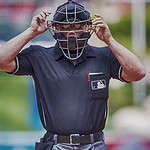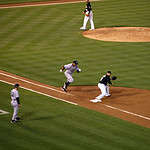K is one of the most commonly used terms in baseball. It is used to describe a strikeout, which is when a batter swings and misses at three pitches or when the umpire calls three strikes against the batter. The term K is believed to have originated from the last letter of the word “strike” since S is already used to represent a sacrifice.
In baseball, strikeouts are an important statistic for both pitchers and batters. For pitchers, a high number of strikeouts can indicate a strong pitching performance, while for batters, a high number of strikeouts can be seen as a weakness in their offensive abilities. Additionally, strikeouts can have an impact on the outcome of a game, as they can prevent runners from advancing and scoring. Therefore, understanding what K means in baseball is crucial for anyone who wants to follow the sport and analyze player performances.

What is K in Baseball?
In baseball, “K” stands for a strikeout. It is a term used to indicate when a batter fails to hit the ball three times in a single at-bat and is, therefore out. The letter “K” is used in scorecards and box scores to denote this event.
The origin of using “K” to represent a strikeout is credited to Henry Chadwick, a 19th-century journalist and baseball statistician. He chose “K” because it was the last letter in the word “struck,” which was how he spelled strikeouts in his scoring system.
Pitchers are usually the ones who get credited with a strikeout, as they are the ones throwing the ball. However, batters can also be credited with a strikeout if they swing and miss on the third strike.
A backward “K” is sometimes used to indicate a called strikeout, where the batter does not swing at the third strike. A forward “K” is used to indicate a swinging strikeout.
Strikeouts are an important statistic for pitchers, as it is an indication of their effectiveness in getting batters out. The pitcher with the most strikeouts in a season is often recognized for their achievement, such as Randy Johnson, Roger Clemens, and Max Scherzer.
While strikeouts are an important part of the game, they are not the only statistic that matters. Other factors, such as earned run average (ERA), hits, and runs, also play a role in determining a pitcher’s effectiveness.
In summary, “K” in baseball stands for a strikeout, which is when a batter fails to hit the ball three times in a single at-bat. Henry Chadwick coined the term, and it is an important statistic for pitchers.
K as a Symbol for Strikeouts
In baseball, the letter “K” is used as a symbol for strikeouts. It represents the third strike that a pitcher throws to a batter, resulting in an out. The use of “K” as a symbol for strikeouts can be traced back to Henry Chadwick, a 19th-century journalist who is considered the father of baseball statistics.
The use of “K” to represent strikeouts is now a standard abbreviation in baseball scoring and statistics. It is commonly used in box scores, scorecards, and other baseball records. The backward “K” is used to indicate a called third strike, while the forward “K” is used to indicate a swinging strikeout.
Strikeouts are an important statistic for both pitchers and batters. For pitchers, strikeouts are a measure of their effectiveness in getting batters out. For batters, strikeouts are a negative statistic, as they represent a missed opportunity to put the ball in play and potentially score runs.
In addition to being an important statistic, strikeouts can also be exciting for fans. The sound of a fastball hitting the catcher’s mitt for a strikeout can be thrilling, and strikeouts can often be a turning point in a game.

Some of the most famous pitchers in baseball history, such as Randy Johnson, Roger Clemens, and Max Scherzer, are known for their ability to strike out batters. Kerry Wood famously recorded 20 strikeouts in a single game in 1998, and Dwight Gooden threw a no-hitter in 1996 while striking out 16 batters.
Overall, “K” as a symbol for strikeouts is an important part of baseball history and scoring. It represents the third strike that a pitcher throws to a batter, resulting in an out, and is used in box scores, scorecards, and other baseball records.
Different Types of Strikeouts
In baseball, a strikeout or “K” is when a batter swings and misses at a pitch, or when a pitch is called a strike by the umpire and the batter doesn’t swing. There are several different types of strikeouts, each with its own unique name and circumstances.
One type of strikeout is the “backward K,” which is when a batter takes a called third strike and doesn’t swing at the pitch. This is denoted with a “K” that is backward-facing in scorecards and box scores. Another type of strikeout is the “forward K,” which is when a batter swings and misses at a pitch for a third strike. This is denoted with a “K” that is forward-facing in scorecards and box scores.
A “swinging strikeout” is when a batter swings and misses at a pitch for any strike, while a “called strikeout” is when a pitch is called a strike by the umpire and the batter doesn’t swing. A “hat trick” is a term used to describe when a batter strikes out three times in one game.
Pitchers can also record different types of strikeouts. A “strikeout looking” is when a pitcher throws a pitch that is called a strike by the umpire and the batter doesn’t swing. A “strikeout swinging” is when a pitcher throws a pitch that the batter swings at and misses.
Overall, strikeouts are an important statistic in baseball and can provide valuable information about a pitcher’s performance. They are denoted with a “K” in scorecards and box scores and can help fans and analysts understand the game better.
The Origin of K in Baseball
The letter “K” in baseball is used to denote a strikeout, which is when a batter fails to hit the ball three times during an at-bat. The origin of this term can be traced back to the 19th century when baseball was still in its early stages of development.
Henry Chadwick, a prominent baseball journalist, and statistician, is credited with creating the box score and many of the statistics used in baseball today. Chadwick is also believed to have been the first to use “K” to denote a strikeout in the late 1860s.
The use of “K” became more widespread in the early 1900s, and it eventually became a standard notation in baseball. Today, “K” is used by scorekeepers and fans alike to keep track of strikeouts during a game.
Several notable pitchers have achieved high numbers of strikeouts throughout baseball history, including Randy Johnson, Roger Clemens, Max Scherzer, Kerry Wood, and Dwight Gooden. Johnson holds the record for the most strikeouts in a single season with 372, while Wood holds the record for the most strikeouts in a single game with 20.
The importance of the “K” in baseball is evident in the fact that it has even made its way into the Baseball Hall of Fame. The New York Mets, for example, have a “K Corner” at Citi Field where fans can celebrate strikeouts and cheer on their pitchers.
Overall, the use of “K” in baseball has become an integral part of the game’s history and culture.
Conclusion
In conclusion, the letter “K” in baseball stands for a strikeout, which is when a batter swings and misses at a pitch or when a pitch is called a strike by the umpire. Strikeouts are an important part of the game, as they allow the pitcher to get outs without relying on the defense.
While strikeouts can be exciting for fans, they are not always the most efficient way for a pitcher to get outs. Pitchers who rely too heavily on strikeouts may run up their pitch counts and tire themselves out more quickly, which can lead to shorter outings and more reliance on the bullpen.
Overall, strikeouts are just one aspect of the game of baseball, and their importance varies depending on the situation. By understanding what the “K” symbol means, fans can better appreciate the nuances of the game and follow along with the action on the field.
- UCLA Softball: Let’s Go Bruins! - February 12, 2024
- Youth Softball Helmet Buying Guide: Keep ‘Em Safe - February 12, 2024
- Youth Softball Pants: Our Top Picks for Your Top Player - February 12, 2024








